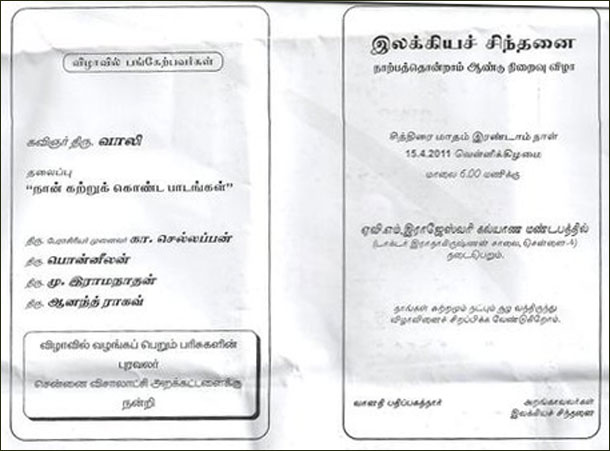Mani Manik
 Generally, it is difficult for the true historians (here ‘true’ represents ‘unbiased’) to make conclusive statement about the Tamil historical events and it is mainly because of the lack of authenticity. They are mostly relying on stone inscription or scripts in metallic plates or palms leaf.
Generally, it is difficult for the true historians (here ‘true’ represents ‘unbiased’) to make conclusive statement about the Tamil historical events and it is mainly because of the lack of authenticity. They are mostly relying on stone inscription or scripts in metallic plates or palms leaf.
But in case of Nadar’s history, abundance of European records available not only in tamilnadu and kerala but also throughout the world (in the form of British military history, Social history of south India, district gazetteers and so on). They clearly explained why the sanars or any other low caste peoples are encouraged during brutish rule…Hereby I am giving a reference to thinnai readers for their own discretion.
http://www.tamilnation.org/forum/sivaram/920715lg.htm
However, I am giving some excerpts from the above link, for those, who have no time to go through all
On Tamil Militarism – a 11 Part Essay
Part 5: The suppression of Tamil military castes
Lanka Guardian, [pp.15-16]
[prepared by Sachi Sri Kantha, for electronic record]
15 July 1992
One of the first concerns of the British as soon as they conquered the southern parts of India was with the ancient and ingrained “habits of predatory war” among the Tamils. The extirpation of these “habits” and culture was considered essential to establishing their authority in Tamil society. The Tamil region was ceded to the British in July 1801; a proclamation was issued by them in December the same year, whereby the use of arms was suppressed and the military service traditionally rendered by the Tamil military castes was abolished.
………………………………..
………………………………………………
The village and district kaval system permeated many levels of rural Tamil society and hence was hinderance to the effective implementation of new form of administration and revenue collection. In some instances kaval was taken over from the military castes and was handed over to the Shanar (Caldwell; 1888, p.224) or anti-Kaval movements were encouraged among non-military castes to coerce them to give up kaval, sell their lands and leave (Madras Presidency Police Administration, 1896). Many efforts were taken to put a stop to the kaval services of the Tamil military castes in the countryside in the first half of th nineteenth century, culminating in the organization of a new police system in 1860, which recruited mostly from among castes which were considered favourable to the British.
…………………………………
……………………………………………
The task of disfranchising the Tamil military castes and destroying the structures of their traditional power in Tamil society was strengthened by the promotion of the Vellalas, Shanaras (Nadaras), Adi-Dravidas and the Nattampadis, who constrasted favourably with the Maravar and suited the aims of revenue, security and conversion. Among these, the Vellalas acquired the most favoured status for the following reasons:
………………………………
………………………………………………
At last, I would like to say some words to my fellow reader Mr. T. Brihadish about my relationship with Nadars. Personally I am highly indebted to Nadar community for providing me education from LKG (KV School, Virudhunagar ) to Post graduation (VHNSN College, Virudhunagar). Till I am keeping ‘deep friendship’ with the persons from that community, after all we are working together in software profession.
While I am reading those ‘so called’ articles for the past few weeks, which are in fact try to mock up the their community by malapropism (The unintentional misuse of a word by confusion with one that sounds similar) I unavoidably feel impatience. Finally I convinced myself that I should compromise the known facts of tamil society on the expense of my personal indebtness to that community. I assure you that I can’t make enmity (hate) with the persons from that community. Still I am respect them. That’s all.
(தயவு செய்து கடிதங்களை தமிழில் எழுதுமாறு கேட்டுக் கொள்கிறோம். – திண்ணை குழு)
- நாகரீகங்களின் மோதல்
- பேட்டின் பிறந்த நாளுக்குப் பிறகு
- நீர்வலை (6)
- சென்னை புத்தகக் கண்காட்சி
- காதல் நாற்பது (3) மாறானவர் நாமிருவரும் !
- எகிப்தின் எழிலரசி கிளியோபாத்ரா (பேரங்க நாடகம்: அங்கம்:5 காட்சி:12)
- “மிஸ்டிக் இண்டியா”- ஓர் அபூர்வ அனுபவம்
- மடியில் நெருப்பு – 20
- நிழல் – பதியம் இணைந்து நடத்தும் குறும்பட பயிற்சி முகாம்
- Evidence of British motive to bring up Nadars
- ஜெயந்தி சங்கர் அவர்களின் நூல் வெளியீடு
- கால்டுவெல் நூல் வெளியீடு
- சிறப்புச் செய்திகள்-5 அல்லது பூனைக்கு மீன்
- கடிதம் : ஆங்கிலம்
- பயாஸ்கோப் பேசிய பாலிடிக்ஸ் – 4
- கடித இலக்கியம் – 40
- நாட்டார் இஸ்லாம்
- விடுதலைப் போராட்ட வீரர் வெ.துரையனார் அடிகளின் தன்வரலாறு: மு.இளங்கோவன் பதிப்பு
- திருக்குறளின் வைப்புமுறை மாற்றத் தக்கதா?
- இலை போட்டாச்சு – 10 – நொறுக்குத் தீனி வகைகள்
- பந்தயம்
- அமண ராகங்கள் !
- ஒரு தரிசனம்
- தாய் நாடு
- இரு வேறு சூல் காலம்


